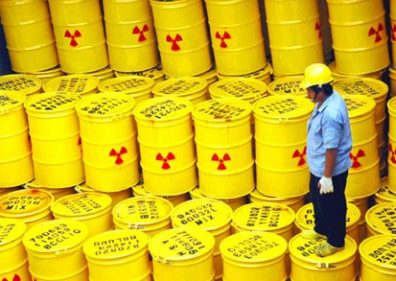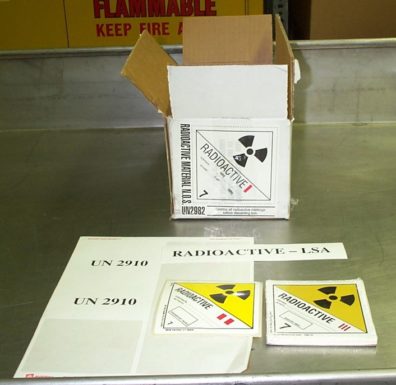Radioactive Waste Training
Radioactive Waste Safety Training
Planning your Waste Production
As you plan your experiment you should take into account the following items. These items pertain to the types of waste you will produce and the volumes of that waste. Disposal of radioactive waste is very expensive.
Use a less radiotoxic isotopes if possible, such as P-33 in place of P-32.
Minimize use of dangerous chemicals (including LSC cocktails) Contact EH&S to determine if your waste is dangerous
Mixed Wastes
In addition, planning should take into account:
Mixed wastes
Mixed wastes refer to wastes that are a mixture of hazardous wastes (i.e., chemicals) and radioactive wastes and, as such, are dually regulated and very expensive to dispose of. If dangerous chemicals must be used, please minimize the volume of waste.

Liquid radioactive waste that is non-hazardous is easier and cheaper to dispose of. In order for waste to be non-hazardous, it must be designated so by the WSU EH&S office. http://www.ehs.wsu.edu/ Please contact them to determine if your waste is hazardous. The waste must also have a pH of between 6 and 9 to be non-hazardous. Please try to minimize your volumes of all radioactive waste.

You should also try to minimize the production of solid radioactive waste. Again it is very expensive to dispose of.


Arrangements must be made in advance for storage of putrefiable radioactive waste.

Non-hazardous scintillation (LSC) cocktails


Ecoscint (only the original, order # LS-271) from National Diagnostics and Optifluor from Perkin Elmer are currently the only scintillation (LSC) cocktails considered to be non-hazardous by WSU EH&S.
Waste Segregation
You must segregate your waste according to half-life. The back of the waste receipt form has more detailed information. This applies to both solid and liquid waste.
 Long Lived- C-14 & H-3
Long Lived- C-14 & H-3  Short lived P-32
Short lived P-32  I-125
I-125
You must fill out the waste receipt form completely and correctly, before your waste will be picked up.
Filling out the Waste Receipt Form


Enter the nuclide that is in the waste.
Enter the chemical makeup, with percentages, of the waste. The percentages should equal 100%.
Circle your waste type. Definitions of the abbreviations can be found on the back of the waste form.
Enter the amount of activity that is in the waste
For liquid waste, enter the pH of the liquid.
Fill in your location.
Fill in your department.
Fill in the date.
The user must also verify that the outside of the containers are free of radioactive contamination. This should be done with a swipe survey.
Radioactive Waste pick-up
In order for you to have your radioactive waste picked up you must:
1) Segregate your waste according to half-life
and place it in appropriate containers.
2) Fill out the waste receipt form completely
and correctly.
3) Ensure that the outside of the containers are free of radioactive contamination.
4) Fill in the waste pick up request form on the RSO web site at, http://www.rso.wsu.edu/radwastepickup.htm

Handling Containers
Inner shipping containers (pigs) may also be discarded as NORMAL trash only after they have been surveyed and found free of contamination and had any and all radioactive labels defaced. These are usually Blue.
Except for ones that contain lead (Pb). Lead is a hazardous waste and can not be discarded in normal trash. These are often Grey in color and are heavy. Contact EH&S for lead recycling.

Waste Containers
The Radiation Safety Office supplies all radioactive materials waste containers to users on campus, free of charge. For liquid waste there are one gallon jugs and five gallon jugs. Please do not use glass bottles for liquid waste. For solid waste there are one cubic foot boxes and two cubic foot boxes.

Release by Authorized Users on the Pullman Campus
Releases to Sewer System (Pullman Campus Only)
In accordance with the Washington State Administrative Code ( WAC 246-221-190 ) Authorized Pullman campus users may release small quantities of non-alpha-emitting radionuclides to the sanitary sewer only if two conditions are met;
1) It is in a readily soluble form or if it is a biological material, it is readily dispersible in water.
2) The chemical compositions are within limits imposed by state environmental health regulations. (No hazardous wastes are allowed; only aqueous wastes may be released, with a PH between 6 and 9). Contact WSU EH&S for assistance in determining if your waste designates as hazardous/dangerous

To ensure that total releases do not exceed regulatory limits, authorized users are not to exceed those release limits listed below.
| Isotope | Monthly Release Limit |
|---|---|
| H-3 | 4,160 microcuries |
| C-14 | 830 microcuries |
| All others (except alpha emitters) | 83 microcuries per isotope |
No alpha emitting isotopes may be discharged by individual authorized users.
Each authorized Pullman campus user must record radionuclide sewer releases on a Radioactive Sanitary Sewer Discharge Record form. Use one form for each radionuclide released for each month in which releases are made. Send copies of completed Radioactive Sanitary Sewer Discharge Records to the Radiation Safety Office for any month in which such discharges take place. Contact RSO for a PDF of this form.
Releases to the Atmosphere
Authorized users may release small quantities of non-alpha-emitting radionuclides to the atmosphere. Each authorized user must record radionuclide releases to the air on a Summary of Radionuclide Disposals to the Air form. Use one form for each radionuclide released for each month in which releases are made. Submit the completed form to the Radiation Safety Office. Contact RSO for a PDF of this form.

Test Time!
- Follow this link to the test. https://myresearch.wsu.edu
- Use your WSU user name and password to sign in.
- Click on the training tab.
- Then click on the available training tab
- Find the radiation safety training waste course, in the “OR” section, click on it and take the test.